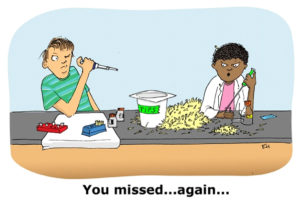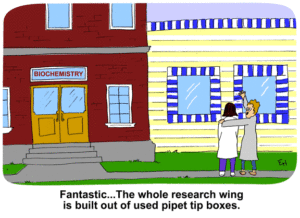Last updated: 1/22/21

Pipettes are such a routine part of everyday life in the lab that it can be easy to take them for granted. Their accuracy is vital, and there are many things we can adopt as best practices for success. Here are a few tips (no pun intended) gathered from around the Web by Kim Steinhauser of the Promega Metrology Department–the group charged with keeping our pipettes and other lab equipment functional and accurate.
Use
- Pre-wet tip. Aspirate liquid into the tip and dispense two or three times before taking up the desired volume.
- Immerse to appropriate depth during aspiration. Immerse the tip below the meniscus. Large volume pipettes should be immersed to 5-6 mm, while smaller volume pipettes should be immersed to 2-3 mm.
- Pause consistently after aspiration and before removing the tip from the liquid. The liquid will continue moving into the tip after the plunger stops, so this consistent pause before removing the tip from the liquid will ensure the amount of liquid drawn into the pipette is accurate.
- Use consistent plunger pressure and speed.
- Aspirate sample at a 90° angle and dispense at a 45° angle. These angles are optimal for ensuring all material is drawn up into, and expelled from, the tip.
- Reduce heat transfer by holding the pipette loosely and setting down when not in use.

Storage
- Store pipettes vertically to avoid contamination.
- Store pipettes dialed to highest volume setting.
- Store away from heat and moisture.
- Pipette tips should be removed prior to storage.
- Keep pipettes clean and free of contaminants
- When cleaning pipettes with bleach solution, do not saturate as fluid can make its way to the piston and cause corrosion.
Happy pipetting!
Acknowledgements
These tips were gathered from this source material:
The following two tabs change content below.


Isobel Maciver
Isobel was a graduate of the University of Edinburgh and of Aston University in Birmingham, U.K. She was a technical writer and editor, and manager of the Scientific Communications group at Promega and later went on to manage web page content and publishing. Isobel's ever helpful and serving spirit, her dry Scottish humor and her kind heart will be forever missed by her Promega Connections colleagues.
Latest posts by Isobel Maciver (see all)
- 3D Cell Culture Models: Challenges for Cell-Based Assays - August 12, 2021
- Measuring Changing Metabolism in Cancer Cells - May 4, 2021
- A Quick Method for A Tailing PCR Products - July 8, 2019
